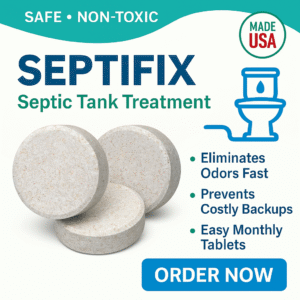Over time, every septic tank collects a layer of sludge—solid waste that sinks to the bottom and does not break down easily. If left unchecked, sludge can clog the drain field, cause backups, and even damage your system. Many homeowners wonder: how to remove sludge from a septic tank? The reality is that while natural bacteria and additives help reduce buildup, true sludge removal requires pumping by professionals. Still, you can support your system with the right practices and tools that minimize sludge growth and keep your septic system healthy between cleanouts.
Quick Picks: Best Products for Managing Septic Tank Sludge
- BioOne Bacterial Septic Cleaner (Case of 12) – Best Overall: natural enzyme and bacteria treatment that helps digest waste and reduce sludge buildup.
- Polylok PL-122 Effluent Filter – Best Budget: prevents sludge and solids from escaping the tank into the drain field.
- Anysun 100-FT Sewer Inspection Camera – Best Premium: allows you to inspect sludge levels and tank health without opening it up fully.
Buyer’s Guide: Understanding Sludge in Septic Tanks
- What sludge is: The heavy solid layer that sinks to the bottom of your tank.
- Why it matters: Too much sludge reduces tank capacity and pushes solids into the drain field, leading to failure.
- How it’s removed: Only a septic pumping truck can fully remove sludge. No additive replaces pumping.
- What you can do: Use bacteria treatments, install effluent filters, and monitor sludge levels between pumpings.
- Maintenance cycle: Pumping is typically needed every 3–5 years, depending on tank size and household usage.
How to Remove & Manage Sludge Safely
- Schedule regular pumping: Hire a licensed septic professional every 3–5 years to remove sludge completely.
- Use bacteria boosters: Monthly treatments like BioOne help digest organic matter and reduce sludge buildup.
- Install an effluent filter: Prevents solids from leaving the tank and clogging your drain field.
- Inspect with a camera: Check sludge thickness before problems arise.
- Adopt septic-safe habits: Avoid flushing wipes, grease, and harsh chemicals that slow bacterial action.
Detailed Product Reviews
BioOne Bacterial Septic Cleaner
Who it’s for: Homeowners looking for a safe, natural way to reduce sludge between pumping visits.
- Key Benefits: All-natural bacteria and enzymes, eco-friendly, safe for all pipes.
- Pros: Easy to use (pour and flush), reduces buildup, septic-safe.
- Cons: Doesn’t replace professional pumping.
Final Verdict: A reliable, eco-friendly way to keep sludge under control year-round.
Polylok PL-122 Effluent Filter
Who it’s for: Anyone who wants to protect their drain field from sludge and solid overflow.
- Key Benefits: Blocks sludge from leaving the tank, reduces field clogs.
- Pros: Affordable, effective, easy upgrade.
- Cons: Needs occasional cleaning by a professional.
Final Verdict: Small cost, big protection—an essential for septic longevity.
Anysun 100-FT Sewer Inspection Camera
Who it’s for: Homeowners who want to track sludge levels without waiting for emergencies.
- Key Benefits: Waterproof camera, 100-ft cable, DVR recording for documentation.
- Pros: Helps spot sludge thickness, cracks, or blockages early.
- Cons: Higher upfront investment.
Final Verdict: A premium diagnostic tool that can save thousands in emergency septic repairs.
Comparison Table
| Product | Type | Best For | Price Link |
|---|---|---|---|
| BioOne Septic Cleaner | Bacteria Additive | Reducing sludge buildup naturally | See Price |
| Polylok PL-122 Filter | Effluent Filter | Preventing sludge escape | See Price |
| Anysun 100-FT Camera | Inspection Tool | Checking sludge levels safely | See Price |
FAQ
1. Can I remove sludge without pumping?
No. Only a septic pump truck can fully remove sludge. Additives help maintain balance but won’t replace pumping.
2. How often should I pump my tank?
Every 3–5 years for most households, depending on tank size and water use.
3. Do septic additives replace pumping?
No. They help digestion but sludge always accumulates. Pumping is essential.
4. How do I know my tank is full of sludge?
Slow drains, foul odors, and water pooling near the drain field are common signs. An inspection camera can confirm sludge levels.
5. What happens if sludge isn’t removed?
It can clog the drain field, cause sewage to back up into your home, and lead to costly repairs or full system replacement.
Conclusion
Removing sludge from a septic tank is a job only a professional pumper can do—but that doesn’t mean you’re powerless. By using natural bacteria treatments like BioOne, installing a Polylok Effluent Filter, and inspecting with tools like the Anysun Camera, you can keep sludge buildup under control and extend the life of your septic system. Think of it as teamwork: you maintain and protect, while pumping crews do the heavy lifting every few years.
